In the corner of a Wawa at 19th and L Streets, Chip Landis, his bicycle secured outside, waits with anticipation, hoping for job notifications on his smartphone. The convenience store, with its seating, power outlets, and restrooms, offers a comfortable spot at 8:30 am after his ride from his Glover Park residence. By 10:30 am, this 58-year-old Bike Messenger has already completed three deliveries: transporting Justice Department documents to the State Department, handling a law firm’s mail run to the post office, and delivering legal binders from the DOJ law library to their Pennsylvania Avenue offices near 13th and New York.
It’s a decent start to a morning following a federal holiday, yet business slows down considerably until after lunchtime. By 7 pm, Landis wraps up his day with a total of twelve deliveries. Compared to his early days in the profession, this is, at best, a half day’s work.
Landis has been a bicycle messenger for nearly two decades, starting just as cell phones began to overshadow pagers and Nextel walkie-talkies as the cutting-edge communication tools in the courier industry. Returning from a decade of teaching English in Taiwan, he sought any available job. The allure of cycling as an independent contractor appealed to him, and with his background as an All-State soccer player from Bethesda–Chevy Chase High, he possessed the necessary athleticism. Why not give it a try?
Today, Landis still cherishes the work. However, he represents a dwindling breed – a relic on two wheels. Much like affordable housing and the iconic half-smoke food carts, DC’s messengers are nearing extinction. With his cycling cap, lean physique, and prominent calf muscles, Landis resembles a retired Tour de France sprinter on his road bike, though on many days, he pedals at a leisurely pace, barely breaking a sweat. At his previous employer, LaserShip, now merged with OnTrac, Landis was the last remaining messenger. “They had 30 couriers when I started,” he recalls. “By the time the pandemic arrived, I was covering the entire city for Laser.”
Landis now works for Washington Express—known as “WEX” among couriers for the past 40 years—a company that once employed numerous messengers but now relies on just a handful. WEX maintains several federal government contracts and offers competitive rates, allowing Landis to earn a viable, though perhaps precarious, living. The State Department, in particular, provides a consistent flow of visa, passport, and embassy-related deliveries. Landis worries that if this stream of work dries up—if passports become digital, mirroring other aspects of modern life—the reduction in deliveries could signal the end of the line for bike messengers like himself.
“I’ll probably be the last messenger at Washington Express someday, too.”
Capitol Flyers: The Heyday of Bike Messengers
Bike messengers were once an integral part of Washington, D.C.’s vibrant cityscape. Throughout the 1980s, 90s, and early 2000s, hundreds of couriers surged through the bustling downtown streets on weekdays. During breaks, Dupont Circle and Farragut Square became informal hubs where the scent of marijuana mingled with the sight of shared beers. In 1998, the city even hosted the World Cycle Messenger Championships, a competition born in Berlin that continues to this day, showcasing the demanding skills required for the profession.
The modern bike courier industry originated in 1960s New York, initially focused on delivering film canisters for movie productions. In DC, the industry revolved around the federal government, its affiliated political offices, courts, and regulatory bodies. As a messenger myself from 1999 to 2004, I witnessed firsthand how Capitol Hill could be a lucrative area. For years, lobbyists seeking to send formal letters, invitations, or small gifts to members of Congress relied on couriers who knew the intricate network of pedestrian tunnels connecting the House and Senate buildings. Pedaling through these historic halls, often sweating and in a hurry, encounters with figures like Joe Biden or Jesse Helms were not uncommon. Even squeezing into the senators-only elevator might lead to an unexpected meeting, such as facing the intense gaze of the diminutive yet formidable Barbara Mikulski.
Bike messengers were seen as “law-flouting, obscenity-spewing, bath-needing, wild-riding, pedestrian-smashing madmen,” who “should be kicked out of downtown forever.”
Occasionally, the job offered glimpses into the inner workings of Washington, revealing the nuanced realities of politics. Delivering legal documents during a steel import trade dispute, I learned that Republican-affiliated law firms often represented foreign interests. Deliveries from Philip Morris to Capitol Hill revealed Big Tobacco’s significant financial support for Black Congressional Caucus candidates and events—a connection later highlighted in a Mother Jones exposé titled “the troubling history of big tobacco’s cozy ties with black leaders.” I still recall Philip Morris’s office manager perpetually smoking at her desk, even after it became socially unacceptable elsewhere.
History sometimes unfolded before our eyes. In those pre-digital days, messengers were often among the first to handle Supreme Court decisions physically. On deliveries to WorldCom and Arthur Andersen, I arrived to witness mass departures, desks being cleared out amidst scandal. It was a paradoxical existence: holding a low-status job yet moving through the most important spaces in Washington, carrying documents tied to major court cases and political debates. This sense of dissonance was a shared experience among messengers.
During his tenure at Laser, Landis obtained a Department of Labor badge, granting him rare access to Hill deliveries post-9/11 anthrax attacks, provided he maintained a presentable appearance. Once, delivering envelopes to a Democratic senator from Illinois, Landis had to remove their contents for security. It was then he realized Barack Obama’s presidential aspirations were more than just hopeful talk.
“Very early [in his campaign], I delivered ten [donor] checks, $5,000 each, to his office—number 713, right in the center of the Hart Building,” Landis recounts. “I walked past Obama going down some steps, this tall African American with two sharp-looking white guys, who were actually telling him they were on their way to a meeting about him becoming the next President.”
“I returned and told a Laser sales representative that ‘Obama fever’ was real. They laughed, saying there was no way a Black man or woman would ever become President of the United States.”
Messenger Madness: Navigating Urban Chaos
Away from Capitol Hill, being a courier was a blend of parkour, NASCAR, and a high-stakes juggling act. Protected bike lanes were nonexistent. Messengers faced car, truck, taxi, and Metrobus drivers who often disregarded their right to the road. Public and press often vilified them. Columnist Bob Levey famously condemned couriers in numerous articles, labeling them “law-flouting, obscenity-spewing, bath-needing, wild-riding, pedestrian-smashing madmen,” demanding their banishment from downtown. Police scrutiny was also intense, with frequent bag searches and threats of citations or bike confiscation for unregistered bikes—a law later found to be discriminatory and repealed in 2008 following a Police Complaints Board investigation.
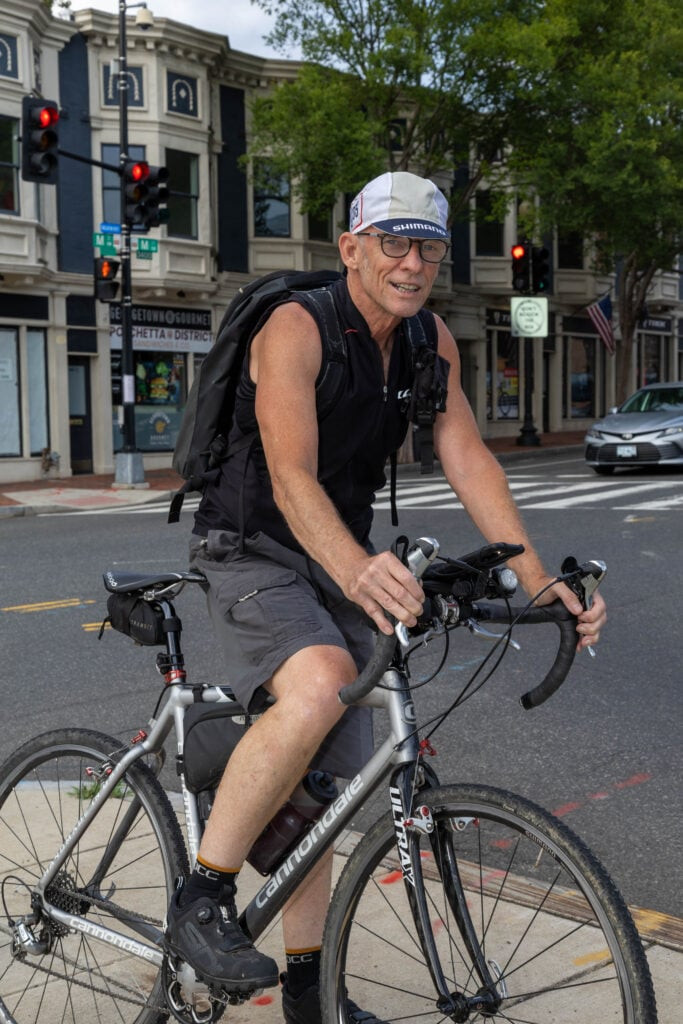 Pat Riggin, a bike messenger since 1989, estimates he's been in over 30 crashes.
Pat Riggin, a bike messenger since 1989, estimates he's been in over 30 crashes.
The job was physically demanding and hazardous. A Harvard School of Public Health study indicated that Boston bike messengers faced an injury rate 13 times higher than the average worker, and three times greater than meatpackers, the next most dangerous occupation. Long-term messengers often bore scars from crashes, stitches, and reset bones.
Pat Riggin, a courier since 1989, estimates enduring over 30 crashes. I recall seeing him one winter morning with swelling and stitches above his eye. When asked about an emergency room visit after a crash, Riggin stated his principle of avoiding high hospital costs, opting to stitch himself up at home instead. In my own worst crash, colliding with a suddenly opened Volvo door, the impact shattered the car’s corner panel and headlight as I was thrown across the street.
On a good day, deliveries involved navigating building security, often opting for stairs over slow elevators, and picking up multiple packages en route, managing tight schedules and varied locations. Exchanges with car couriers covering the Beltway were common. Messengers often juggled work for multiple companies, a secret kept from dispatchers.
The strategy was to move east to west, between Capitol Hill, K Street, and Georgetown, adjusting north and south as needed. Lunch breaks offered a brief respite, ideal for lucrative deliveries to Alexandria or Bethesda, jobs messengers preferred to handle themselves rather than passing to car couriers for minimal commission. However, afternoons brought a surge of rush filings for regulatory agencies—DOC, ITC, FTC, FEC, and SEC—with staggered deadlines between 4:30 and 6 pm, federal clerks locking doors precisely on time.
In my worst crash, I hit a suddenly opening door of a Volvo so hard that the impact smashed the car’s corner panel and headlight as I catapulted down the street.
The job involved earning $12 for rush deliveries, serving high-powered attorneys charging $250 hourly rates, and facing scenarios like picking up a 4:45 pm filing from a Georgetown firm needing to be stamped at the Federal Energy Regulatory Commission by 5 pm. It was high-stakes, with personal and professional consequences. A former DC lawyer recounted, “I remember once our courier got hit by a car, delaying a document filing. We appealed, explaining the ‘act of God’ scenario. The judge was unmoved and ruled against us.”
Digital Death Spiral: The Decline of the Bike Messenger
Pat Riggin, despite his demanding career as a bike messenger, held a degree in cartography from the University of Maryland (1986) and briefly worked in the field. However, his passion for competitive road racing, developed in college, led him to couriering part-time soon after graduation. “I had options,” Riggin says, “but I couldn’t imagine being in an office when I could earn money doing what I loved.”
Long before the term “gig economy” became common, messengers lived a precarious existence. Health insurance, paid vacation, and benefits were nonexistent. High turnover was typical; veterans hesitated to learn new recruits’ names until they proved their staying power through a winter. Female messengers were rare, facing considerable sexism while on the job.
Yet, those who persevered felt a strong connection to the lifestyle—akin to surfers or mountain climbers, finding a way to live and work around their passion. The profession attracted a diverse group, transcending age, race, ethnicity, and class barriers. No formal education was required, and ex-offenders were often welcomed. Landis suggests that couriering offered an alternative for those who struggled in conventional workplaces or dealt with conditions like undiagnosed ADHD.
Landis himself has been sober for 15 years, and he’s not alone in finding solace and support within the messenger community. “The exercise, sunlight, and endorphins—it helps with depression and anxiety,” he notes. “The constant movement keeps things at bay.”
Inherently anti-establishment, and sometimes antisocial, messengers fostered a strong camaraderie, based on shared risks and a DIY ethos. In 1995, 80 DC couriers participated in their first nighttime alley-cat race and scavenger hunt, mirroring a chaotic workday. These races, along with summer time-trial races in Rock Creek Park and bike-polo nights, continue to this day, blending competition, community, and celebration.
During couriering’s golden age, Riggin supplemented his racing and training by working as a commissioned contractor, funding bike-packing trips to exotic locations. Business thrived so much that in 2000, he co-founded Real Courier with fellow messenger Matt Dwyer. “It was crazy back then,” Riggin recalls. “Major law firms generated so much work.”
 More bike messengers racing through city streets.
More bike messengers racing through city streets.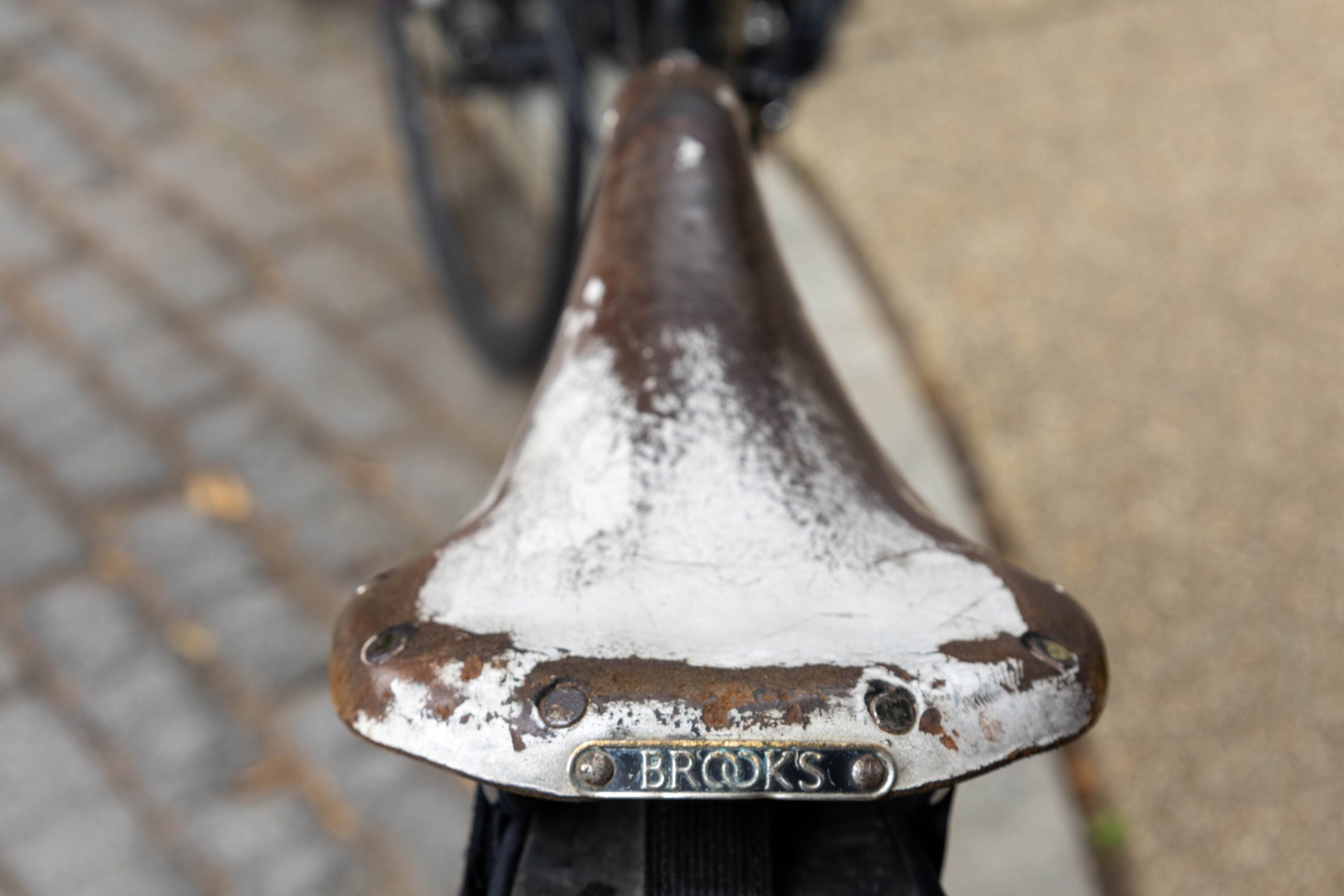 A bike messenger navigates a tight turn during a race.
A bike messenger navigates a tight turn during a race.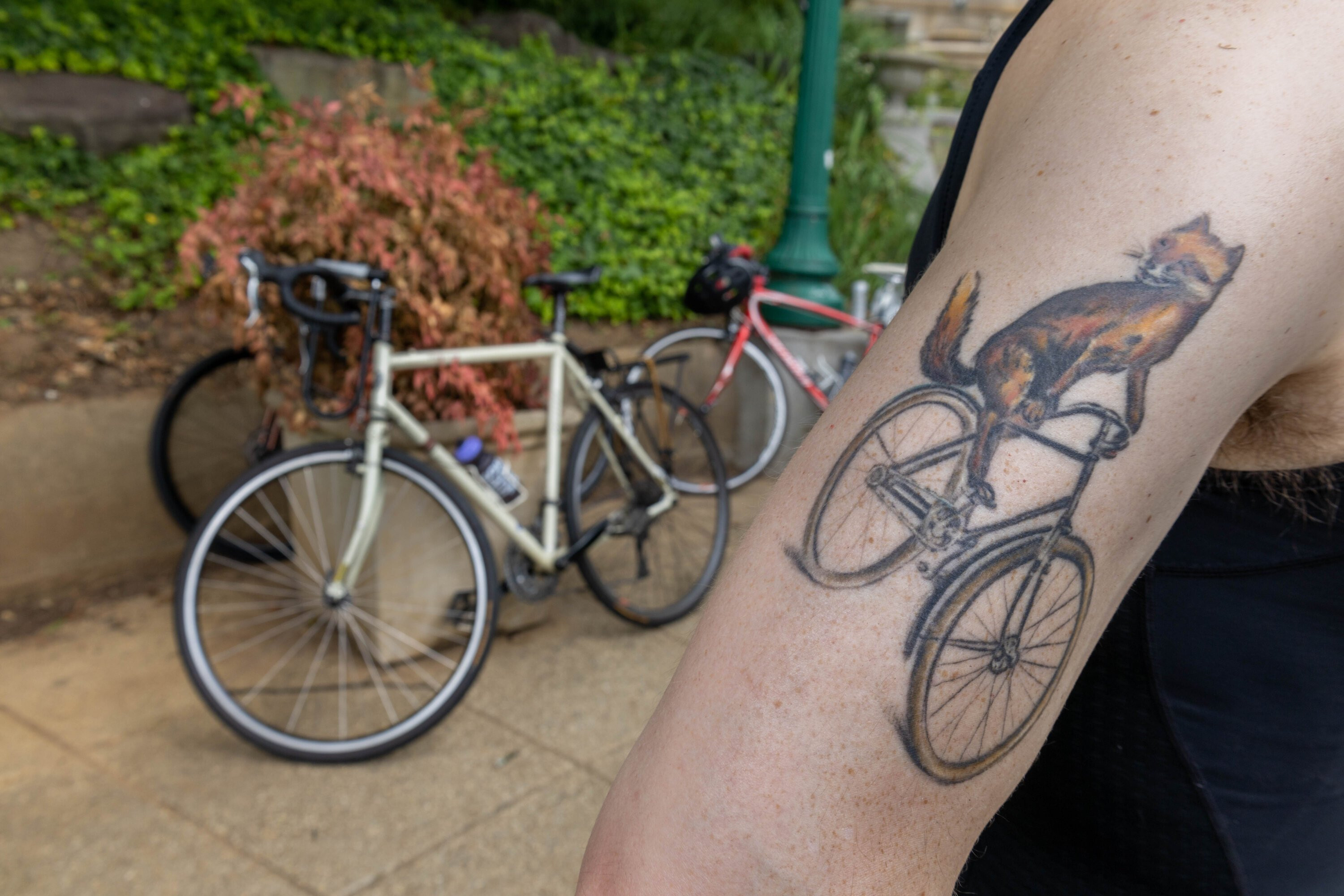 A group of bike messengers at an alley-cat race.
A group of bike messengers at an alley-cat race.
However, change was looming. Fax machines and email, initially feared, had a limited impact. September 11th marked a turning point. On that day, I witnessed the first plane hit the Twin Towers while preparing my messenger bag. Moments later, my pager buzzed with a job from a law firm on Pennsylvania Avenue. Cycling past the White House, the unusual emptiness struck me.
A month later, anthrax attacks targeting Senate offices intensified the city’s anxiety. Terror alerts became routine, and deliveries to Capitol Hill ceased. Messengers carrying envelopes were treated with suspicion. Capitol Hill Delivery laid off its entire staff.
The industry began a slow decline driven by digitization. Federal agencies and courts increasingly adopted electronic filing. The pandemic accelerated this shift, making digital submissions the only option. Like video store clerks before them, bike messengers became obsolete, their specialized skills and urban knowledge no longer essential. (While the Department of Labor lacks specific statistics for bike messengers, New York City saw an estimated decrease of roughly 1,000 messengers between 1998 and 2008.)
Many former messengers transitioned to bike-related careers, becoming mechanics, builders, or shop employees. Riggin has remained in the delivery sector, albeit in a different form. Now 65, he delivers in the Maryland and Northern Virginia suburbs, but in his Toyota 4Runner. “I’d like to sell the company, honestly,” he admits. “I’m ready to retire.”
Riggin owns property near Harrisonburg, Virginia, a mountain biking destination, where he spends weekends riding. Weekdays, he manages 90-minute training rides after work. “My dream is to build guest cabins and lead bike tours,” he says. “Things evolve. You adapt or move on.”
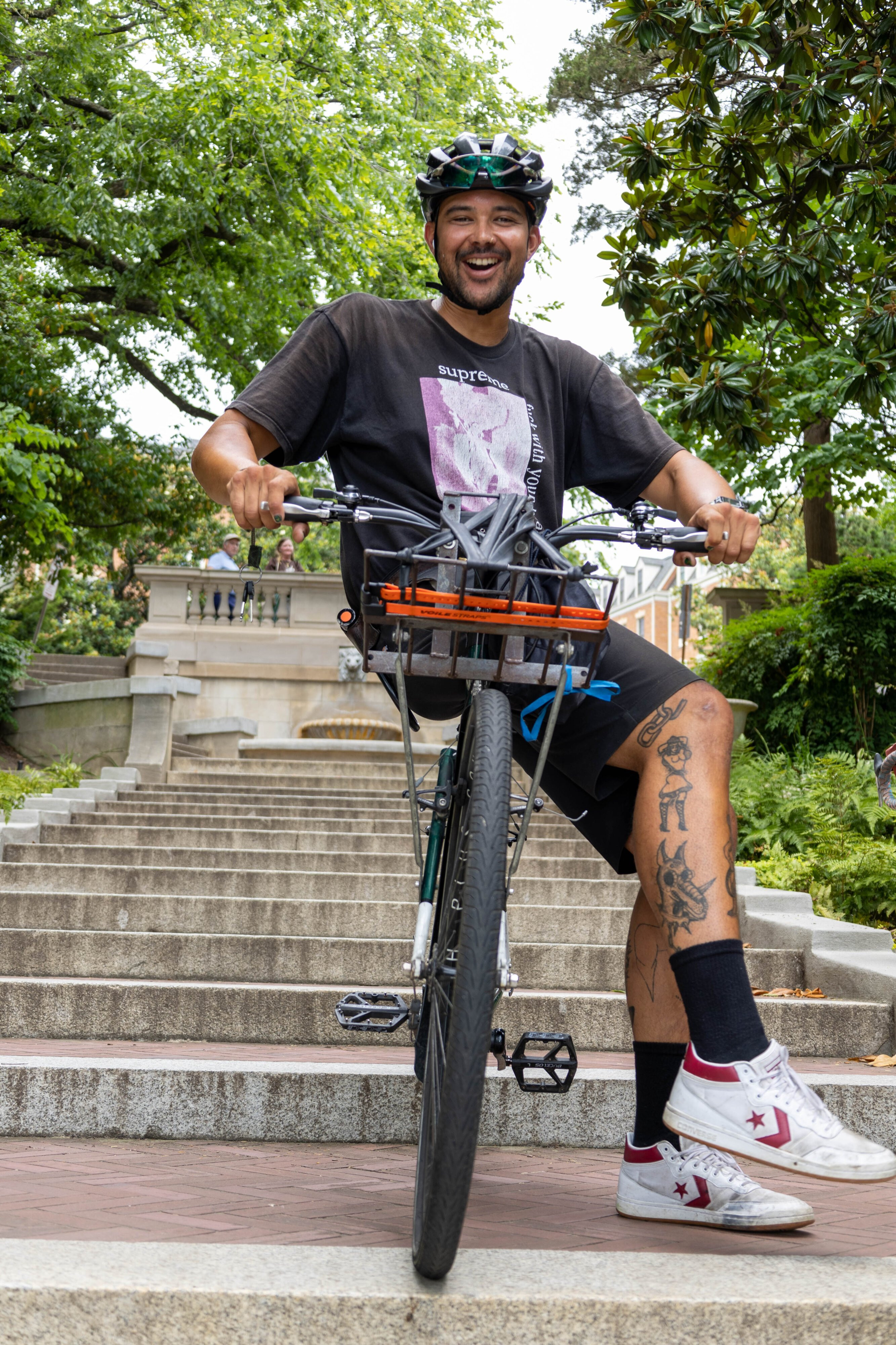 Brian “Bigs” Clark, a courier and race organizer, also designs and sews messenger bags.
Brian “Bigs” Clark, a courier and race organizer, also designs and sews messenger bags.
“Thank a Bike Messenger”: Legacy and Lasting Impact
“Okay, okay, okay!” Paul “P.J.” Joyner calls out to a group of current and former messengers and cyclists gathered on Kalorama’s “Spanish Steps.” It’s a hot Sunday in June, and they’re preparing for a 16.5-mile alley-cat race.
A moped with a “F— TRUMP” sticker starts up, and the cyclists follow, chasing the rider up Connecticut Avenue, a challenging uphill start, weaving through traffic like bees from a disturbed hive. Checkpoints include the Swiss Embassy, a lunch spot at 18th and I, a closed cafe on K Street, and the Government Publishing Office’s old messenger entrance—a vestige of the pre-PDF era. Next is a sprint to a restaurant in Northeast, then through the National Mall, dodging tourists to reach the 14th Street Bridge.
The heat and pace are demanding. Joel Gwadz, 56, a former courier and competitive mountain biker, experiences heat exhaustion, crashing on a Mount Vernon Trail ramp. “Once I realized it wasn’t a heart attack,” he jokes, “I cooled down and got back on track.”
Andrew Timberg, a 21-year-old Columbia University student and part-time food courier, wins. He receives a dumpster-found trophy, relabeled “ANDREW.” It’s a symbolic passing of the torch. Timberg laughs, “It’s cool to be part of the messenger legacy.”
“Funny thing? It’s my first trophy. Ever.”
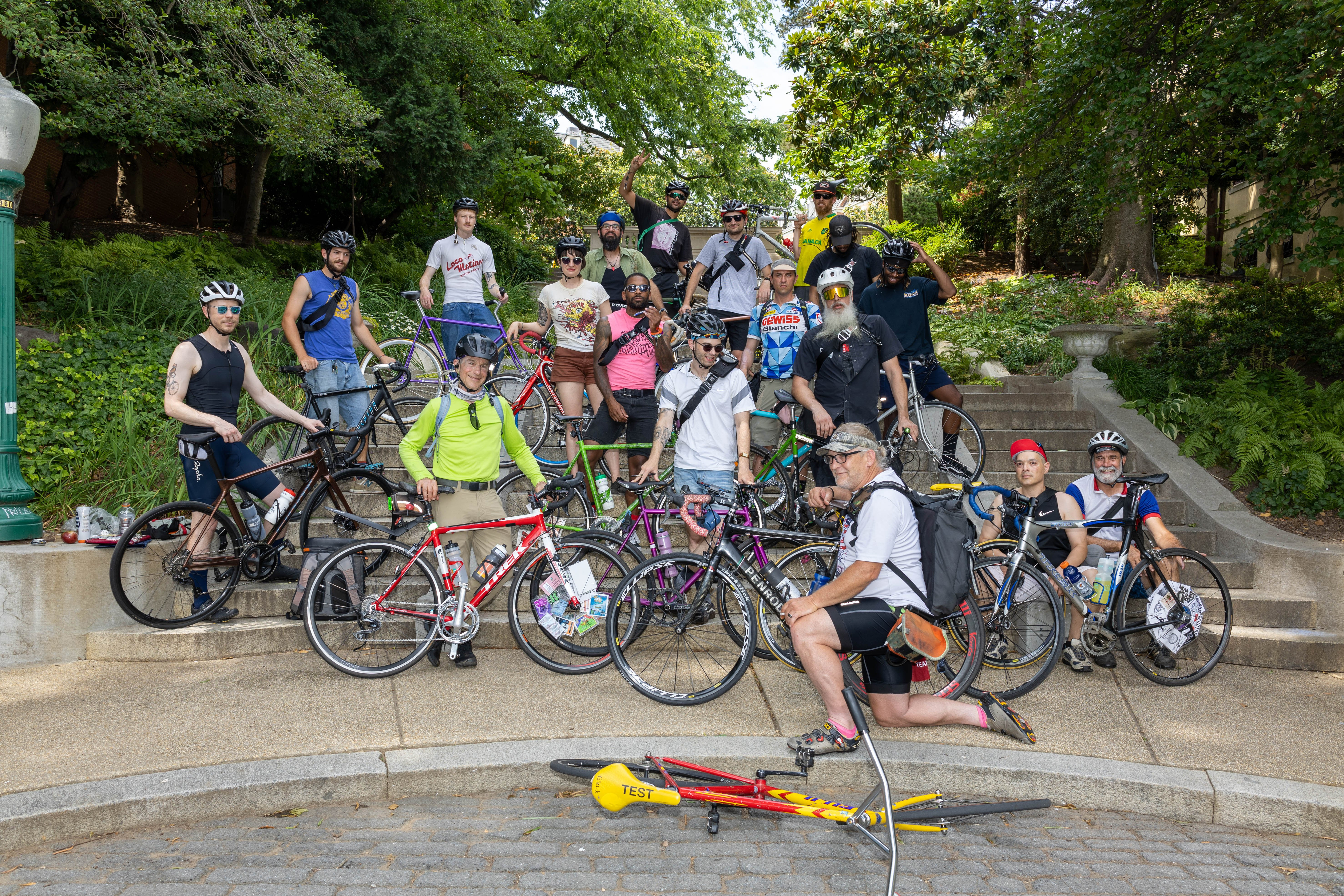 Messengers and cyclists gather for an alley-cat race in Kalorama.
Messengers and cyclists gather for an alley-cat race in Kalorama.
What is the legacy of DC’s bike messengers? For some, it’s the cultural impact—messenger bags as fashion items, track bikes in hipster circles. For me, it’s a lasting love of cycling and memories of an unforgettable job. Many former couriers share this sentiment, staying connected and reminiscing on a Facebook page managed by Landis.
More profoundly, the messenger legacy is evident in DC’s bike-friendly infrastructure. They presented an alternative to car culture, paving the way for bike lanes and cycle shares. Former messenger Eric Gilliland became the second director of Capital Bikeshare, hiring other ex-messengers for key roles. Stephanie Bastek, from the American Scholar, notes, “Radicals on the street drive change, politicians take credit.”
“If you use bike lanes, thank a bike messenger.”
Holding Out, Holding On: The Last of Their Kind
Back at Wawa, Landis eats an egg-and-bagel sandwich. A philosophy graduate, he still looks the part. During downtime, he reads Chinese books in their original script. He acknowledges the irony: digitization, while decimating his industry, enables his passion for Chinese culture. “That’s the internet, right? You can download anything,” he says wryly.
Bike messengers presented an alternative to car culture. Pedaling through DC’s auto-dominated streets, we paved the way for today’s explosion of bike lanes and cycle shares.
Landis knows his career is finite. Delivery work is declining, and he’s feeling the physical toll. “Physically, it’s starting to hurt. Saturdays are for recovery.” He considers an e-bike, like food-delivery couriers—representing the future of bicycle hustling, but without the intense pace and volume of deliveries.
Layoff is a possibility, but quitting is not in his plans. Discussing the physical demands of aging as a cyclist, Landis reveals recent high blood pressure diagnosis and medication. “It’s genetic,” he explains. Smiling, he adds, “My doctor thinks I should keep doing this as long as I can.”
This article appears in the September 2024 issue of Washingtonian.
More: FeaturesBikeDC History
